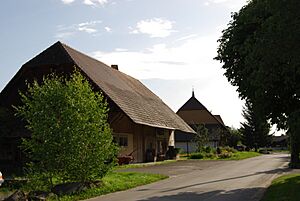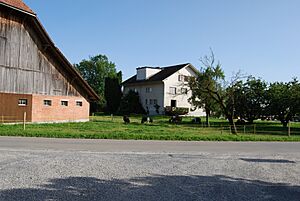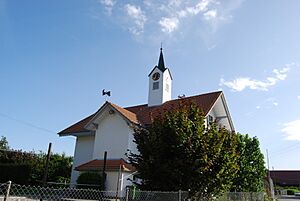Gurbrü facts for kids
Quick facts for kids
Gurbrü
|
||
|---|---|---|
 |
||
|
||
| Country | Switzerland | |
| Canton | Bern | |
| District | Bern-Mittelland | |
| Area | ||
| • Total | 1.86 km2 (0.72 sq mi) | |
| Elevation | 484 m (1,588 ft) | |
| Population
(Dec 2020 )
|
||
| • Total | 254 | |
| • Density | 136.6/km2 (353.7/sq mi) | |
| Postal code |
3208
|
|
| Surrounded by | Wileroltigen, Ferenbalm, Agriswil, Ried bei Kerzers, Kerzers | |
Gurbrü (French: Corbruil) is a small municipality in Switzerland. It is located in the Bern-Mittelland administrative district within the canton of Bern. Gurbrü is a quiet, rural area known for its farms and green fields, showing what a traditional Swiss village is like.
Contents
History of Gurbrü
Gurbrü was first mentioned in official records way back in 1214. At that time, it was called Gurbru.
Early Times and Bern's Influence
During the Middle Ages, Gurbrü was part of a territory called the Herrschaft of Oltigen. This was like a local lordship or area ruled by a noble family. Around 1410 to 1412, the powerful city of Bern took control of this entire Herrschaft, including Gurbrü.
The village has always been part of the church area, or parish, of Kerzers. In 1528, during the Protestant Reformation, both Gurbrü and Kerzers changed their religion to the new Protestant faith. Gurbrü stayed connected to the Kerzers parish after this change.
Land Disputes and Modern Changes
In 1793, Gurbrü had a disagreement with nearby communities in the Canton of Fribourg over a marshy area called the Gurbrümoos. Today, this moorland is part of the municipality of Kallnach.
After the French invasion in 1798, Gurbrü remained part of the Canton of Bern. This was despite efforts by the Canton of Fribourg to take it over. In 1901, a railroad line was built, and a train station opened in Gurbrü, connecting the village to other towns.
Geography and Landscape
Gurbrü is located in the Swiss plateau, which is a flat area in Switzerland. It sits near the edge of a large marshy area called the Grosses Moos.
Land Use in Gurbrü
Most of Gurbrü's land is used for farming. About 70.7% of the area is farmland, where crops are grown and animals graze. Forests cover about 9.8% of the municipality. The rest of the land, about 19.0%, is developed with buildings and roads.
Specifically, about 54.3% of the farmland is used for growing crops. Another 13.6% is used for pastures where animals like cows can eat grass.
Villages and Transportation
Gurbrü includes the main village of Gurbrü and a smaller settlement called Stämpflerei. Stämpflerei used to belong to Ried bei Kerzers in the Canton of Fribourg until 1854.
The A13 highway passes through Gurbrü, but there isn't an exit directly in the municipality. A railway line also runs through Gurbrü, but the closest train station is in Ferenbalm. From Ferenbalm, you can travel by train to Bern. However, many people find it easier to use the train connections from the nearby town of Kerzers, which offers routes in four directions.
Gurbrü's Coat of Arms
The official coat of arms for Gurbrü is described as: Azure a Ploughshare Argent and Mount of 3 Coupeaux Vert. This means it shows a silver (Argent) plow blade on a blue (Azure) background. Below it, there is a green (Vert) hill with three small peaks. The plow blade likely represents the importance of farming in the area.
Population and People
Gurbrü has a population of about 244 people (as of December 2011).
Population Changes
Over the ten years from 2001 to 2011, the population of Gurbrü slightly decreased. This was mainly because more people moved out of the municipality than moved in.
Languages Spoken
Most people in Gurbrü speak German as their main language. About 97.1% of the population speaks German. A smaller number of people speak French (2.1%) or Portuguese (0.8%).
Where People Live
In 2000, about 38.7% of the people living in Gurbrü were also born there. Another 33.2% were born in the same canton (Bern). About 24.4% were born elsewhere in Switzerland, and a small number (2.5%) were born outside of Switzerland.
Age Groups
As of 2011, children and teenagers (up to 19 years old) make up about 23.4% of Gurbrü's population. Adults (20 to 64 years old) make up 53.7%, and seniors (over 64 years old) make up 23%.
Population Over Time
The chart below shows how Gurbrü's population has changed over many years:

Economy and Jobs
In 2011, Gurbrü had a very low unemployment rate, at just 0.69%. This means almost everyone who wanted a job had one.
Types of Jobs
Most jobs in Gurbrü are in the primary economic sector. This sector includes jobs like farming and agriculture. In 2008, 112 people worked in this sector, with about 15 businesses involved.
A small number of people, 2, worked in the secondary sector, which includes manufacturing. The tertiary sector, which involves services, had 11 people working in 6 businesses. These service jobs often include things like sales or repairs.
Commuting for Work
In 2000, many people who lived in Gurbrü traveled to other places for work. About 95 workers commuted away from the municipality. Only 12 workers came into Gurbrü to work from other areas. This means Gurbrü is a "net exporter" of workers, with more people leaving for jobs than coming in.
About 80% of the people who worked in Gurbrü also lived there. For getting to work, about 18.9% used public transportation, and 44.8% used a private car.
Religion
Based on the 2000 census, most people in Gurbrü belong to the Swiss Reformed Church, which is a Protestant denomination. About 81.9% of the population were Swiss Reformed.
A smaller group, about 7.1%, were Roman Catholic. There were also a few people who belonged to other Christian churches. About 8.82% of the population said they had no church affiliation, meaning they were agnostic or atheist.
Education
In Gurbrü, many adults have completed higher levels of education. About 59.7% of the population has finished non-mandatory upper secondary education. This is like high school or vocational training.
Additionally, 18.7% of the population has completed even higher education, such as attending a university or a Fachhochschule (a type of university for applied sciences).
School System in Bern
The school system in the Canton of Bern works like this:
- Kindergarten: Students start with one year of non-required Kindergarten.
- Primary School: This is followed by six years of Primary school, which is mandatory.
- Lower Secondary School: After primary school, students attend three years of mandatory lower Secondary school. Here, students are grouped based on their abilities and what they are good at.
- Further Education: After lower secondary school, students can choose to continue their schooling or start an apprenticeship to learn a trade.
Students in Gurbrü
During the 2011–12 school year, 24 students attended classes in Gurbrü. There were no kindergarten classes in the municipality. The municipality had 2 primary classes with these 24 students. A small percentage of these primary students were not Swiss citizens, and some had a different first language than the one used in the classroom.
In 2000, most students (16 out of 17) who attended school in Gurbrü also lived there. However, 17 residents of Gurbrü attended schools outside the municipality.
See also
 In Spanish: Gurbrü para niños
In Spanish: Gurbrü para niños








